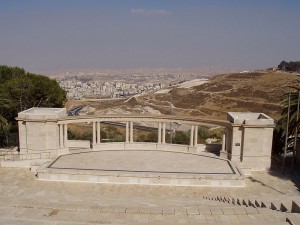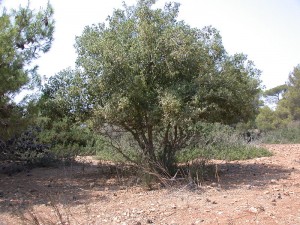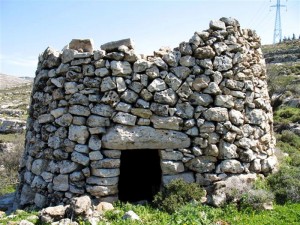
View of the Judean Desert from Mount Scopus
From Friday night to Saturday night Jews all around the world will be celebrating Yom Kippur, the Day of Atonement. This is based on a commandment in the Bible, on the 10th day of the Jewish month of Tishrei to fast and atone for our sins. Many religious Jews will be reading descriptions of the ceremonies carried out for the day of atonement in the Temple in Jerusalem. One thing that has lessened in time, due to the destruction of the Temple in 70 CE is an understanding of the great drama that was played out every year in Jerusalem. A lot of the Drama would surround the High Priest, it was told that if he was not in favour with God, he would not leave the inner chamber of the Temple alive. Another part of this drama was focused on two goats. The High Priest was commanded two take two goats; one for God and one for ‘Azaze (a tall cliff). One goat was to be sacrificed to God, one goat was to have the sins of Israel placed upon it and thrown from a cliff into the Judean Desert. Once the Scapegoat, the goat of the sins of Israel had met its end in the Judean wilderness there would be great rejoicing, as this was a sign that the sins of Israel had been forgiven.
So How Did They Know when the Scapegoat had arrived in the Desert?
The question above, is not my own, it is in fact a question that appears in ancient collection of case law called the ‘Mishnah’ dating from between the 1st century BCE to the 3rd century CE (Mishnah: Yoma 6:8). The context of the question is that, the High Priest would be told immediately when the goat was in the desert. The chapter of Mishnah goes on to explain a system of runners and stations, where at each stage of the goats descent into the desert his progress would be reported.
Its Not that far
The one factor that a person who has never been to Jerusalem could miss is that is not actually that far from Jerusalem to the Judean desert. As we can see in the picture above, the Judean desert can even be pictured from parts of Jerusalem (mount scopus is about a 40 minute climb from the Old City).
Spiritual Rise, Physical descent.
The other thing to notice is that the trip to the Judean desert is all down hill, its one big descent to the LOWEST PLACE ON EARTH. This physical descent is mirrored by the spiritual rise of the Jewish people, the removal of their sins. In fact their is Mishnaic saying that ‘There was no happier time in israel than Yom Kippur and the Fifteenth of Av’ (Mishnah Ta’anit 4:8). Yom Kippur is a happy day because the sins of the Jewish people are forgiven and this process brings the participants closer to God.
Dedicated to the health of Zlata bat Sima and a better year for humanity.
 What’s a Terebinth?
What’s a Terebinth?

